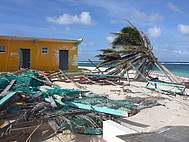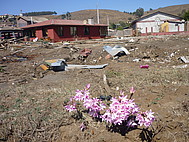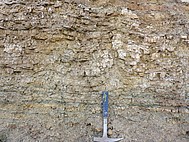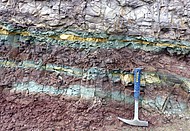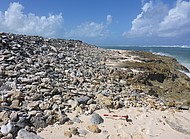Natural Hazards
Natural hazards can significantly modify or even destroy nature and living enviroments within a few minutes to hours. Thereby, the different types of hazards, such as landslides, earthquakes, volcanic eruptions, tsunamis, meteorite impacts or storms, leave characteristic deposits. The analyses of these deposits helps to understand related processes and allows for the developement of advanced early warning and protection systems. Historical and fossil deposits of natural hazards provide valuable information on intensities and recurrence intervals of the respective events. Thus, the geological past is a key to be better prepared for future events. news1, news2, news3
Stratigraphy of the Triassic and Jurassic in southern Germany and northern Switzerland
Sedimentary rocks of Triassic (251.9 to 201.3 Ma) and Jurassic age (201.3 to 145 Ma) are widespread throughout southern Germany and northern Switzerland. Typical landscapes are the reddish-brown rock formations of the Buntsandstein, the South German Scarpland or the Swiss Jura Mountains. The region has a multifarious past, shifting several times from terrestrial to marine conditions. Terrestrial deposits document humid conditions (riverine deposits of the Buntsandstein), but also arid phases (gypsum and salt of the Upper Triassic). Corals, fish, ichthyosaur, shells, sea urchins, sea lilies, ammonites and numerous other marine species were living in the tropical waters of the Jurassic ocean.
Coastal Geology
Coasts are highly dynamic environments. Depositional and erosional processes act on short, medium and long time scales, such as storm events, saisonal changes in wind or wave energy and long-term sea level changes. Wind and waves are the agents that sculpture coasts. For example, waves transport fine material onto the beach, wind then picks up the material, transports it landwards, eventually building dunes. In contrast, spring tides or storm surges can erode material and transport it back into the sea. Erosional processes prevail along rocky coasts, as for example evidenced by cliff collapses. Sea level changes, most of all a rising sea level, affect coasts in the long term.
Geological documentation of the department's paleontological excavations
The geological department conducts paleontological excavations in Baden-Wuerttemberg, for example Miocene fauna at Höwenegg and Öhningen (Hegau) and Oligocene fossils in the Unterfeld (Rauenberg) clay pit. The Section Geology, Mineralogy and Sedimentology supports these excations with stratigraphic profiles and facies analysis. These approaches allow to reconstruct the depositional enviroment and habitat in great detail. Sediments provide manifold information on processes and conditions, such as climate, oxygen content of sea or lake water, short-term events (e.g. volcanic eruptions, heavy rain fall) and many others, that prevailed millions of years ago. news1, news2




